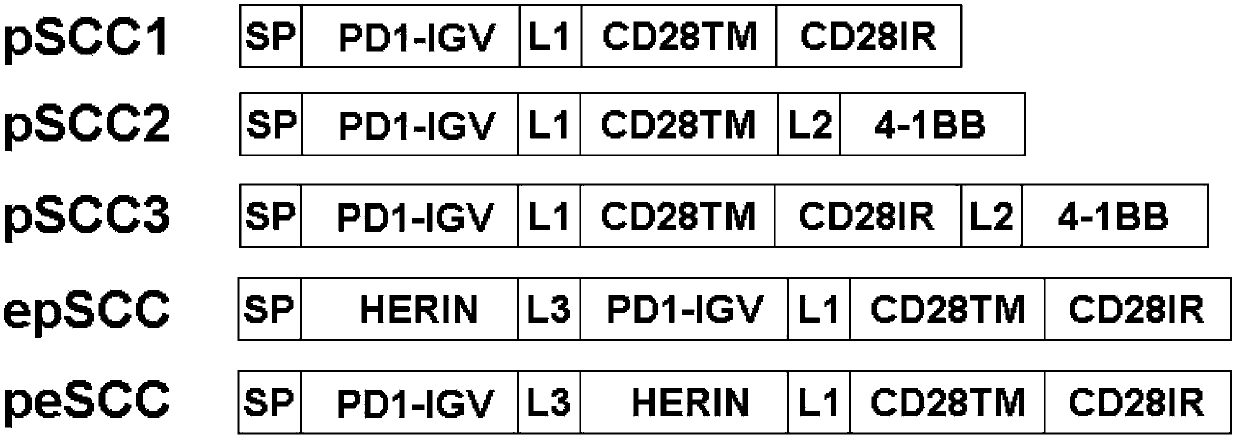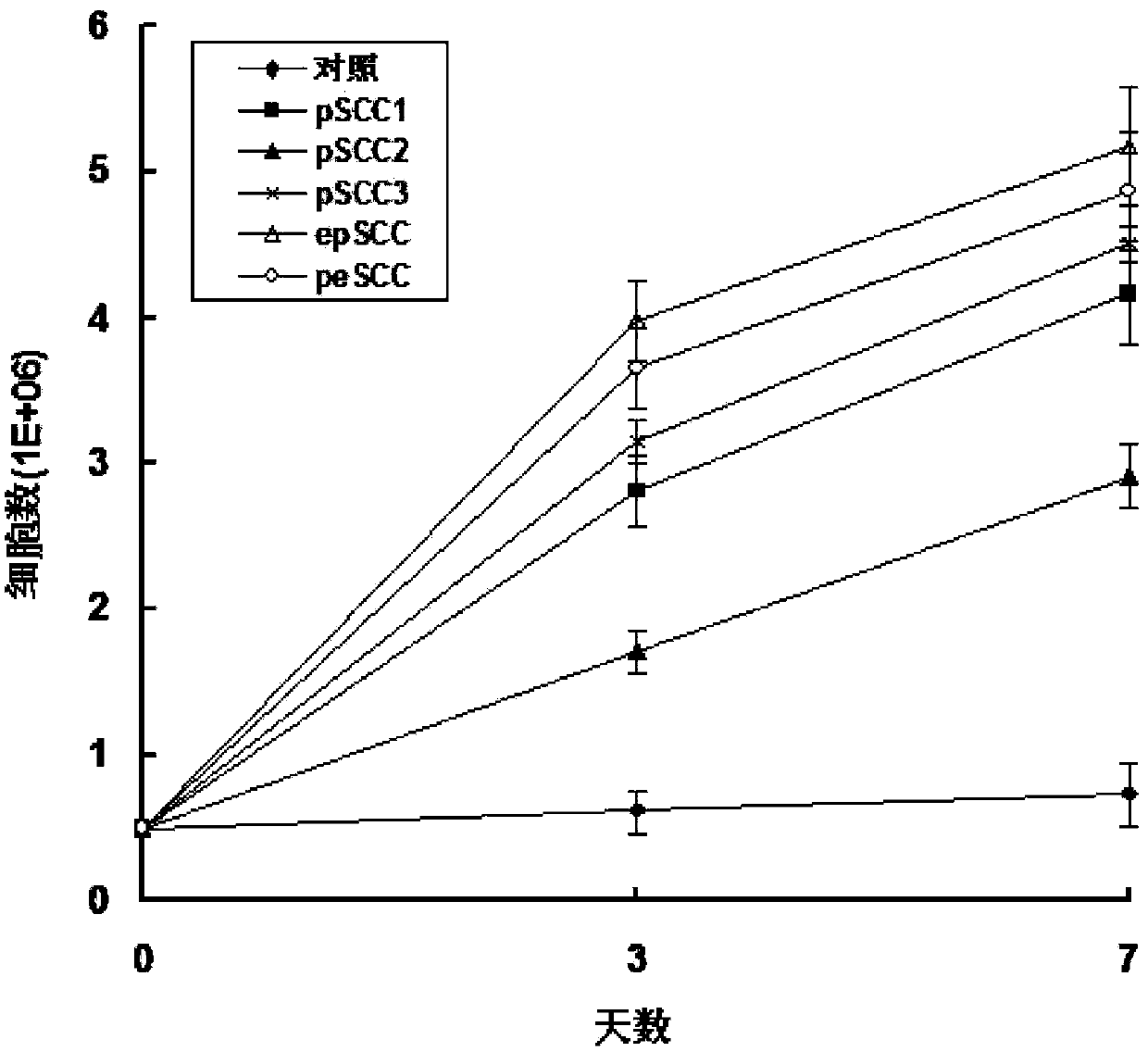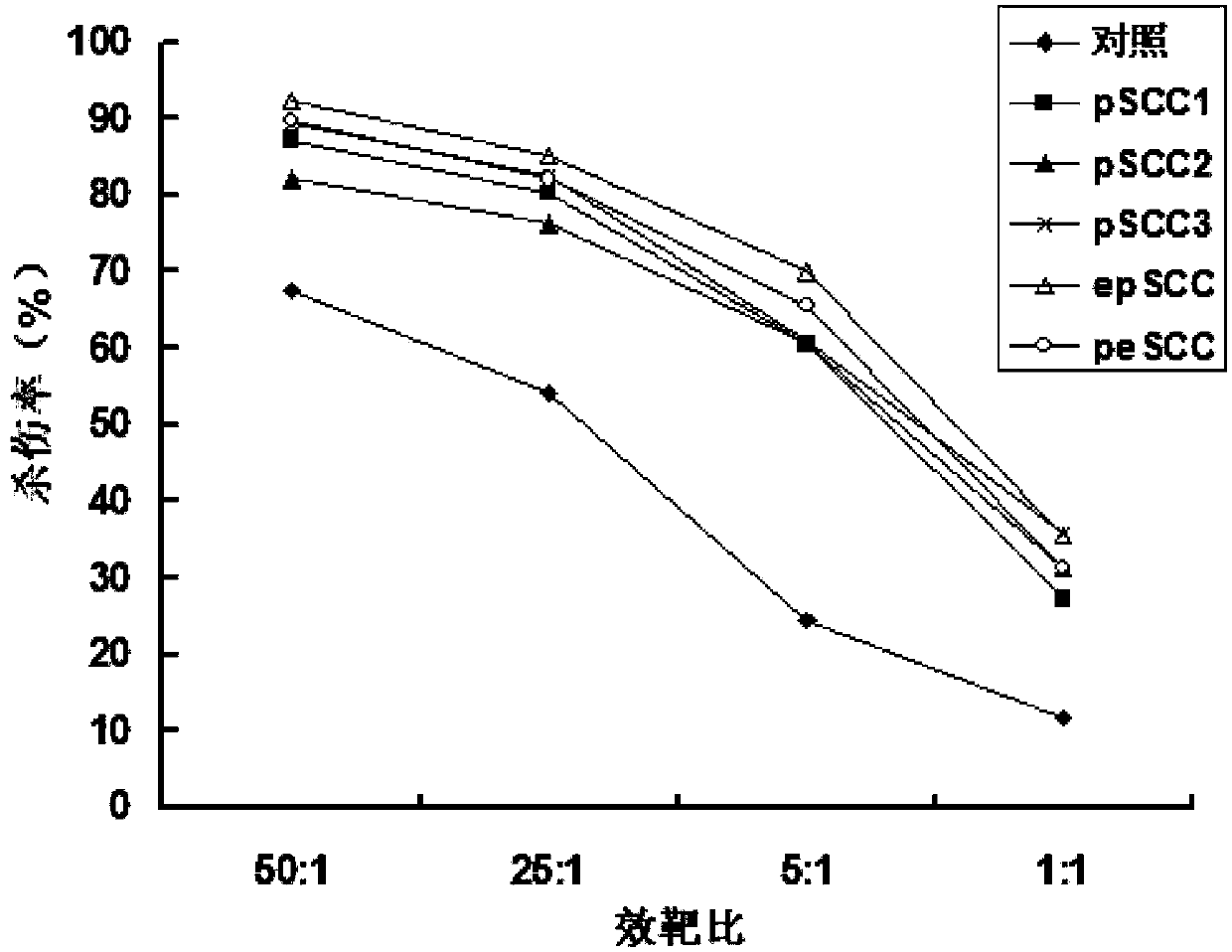Single chimeric converter for T-cell signal and application thereof
A molecular and tumor cell technology, applied in the fields of molecular biology and immunology, which can solve the problems of invasion and metastasis, malignant proliferation of tumor cells, etc.
- Summary
- Abstract
- Description
- Claims
- Application Information
AI Technical Summary
Problems solved by technology
Method used
Image
Examples
Embodiment 1
[0074] Example 1: Synthesis of Fusion Protein Expression Cassette and Construction of Expression Vector
[0075] According to the amino acid sequence and coding sequence of each component of the fusion protein, the entire fusion amino acid sequence and coding DNA expression frame are spliced, as follows:
[0076] The amino acid residue sequence of PD1-IGV is:
[0077] GDNATFTCSFSNTSESFVLNWYRMSPSNQTDKLAAFPEDRSQPGQDCRFRVTQLPNGRDFHMSVVRARRNDSGTYLCGA (SEQ ID NO: 1)
[0078] The coding sequence of PD1-IGV is:
[0079] GGGGACAACGCCACCTTCACCTGCAGCTTCTCCAACACATCGGAGAGCTTCGTGCTAAACTGGTACCGCATGAGCCCCAGCAACCAGACGGACAAGCTGGCCGCCTTCCCCGAGGACCGCAGCCCAGCCCGCCAGGACTGCCGCTTCCGTGTCACACAACTGCCCAACGGGCGTGACTTCCACATGAGCGTGGTCAGGGCCCNOGT2GCAATGACAGCGGCACG
[0080] The amino acid residue sequence of CD28 transmembrane domain (CD28TM) is:
[0081] PFWVLVVVGGVLACYSLLVTVAFIIFWVRS (SEQ ID NO: 3).
[0082] The coding sequence of the CD28 transmembrane region (CD28TM) is:
[0083] CCCTTTTGGGTGCTGGT...
Embodiment 2
[0133] Example 2: Isolation and culture of liver cancer tissue-derived TIL cells
[0134] Collect freshly resected HCC specimens and process them immediately under sterile conditions. The specific method is as follows: remove the normal tissue and necrotic area around the liver cancer specimen, remove small tissue pieces with a size of 1-2mm3 from different areas of the specimen, and place one piece in each well of a 24-well plate. Add 2 mL complete medium (GT-T551 medium containing 10% FBS) and 3000 IU / mL IL-2 to each well. Place the 24-well plate in a 37°C, 5% CO2 incubator. On the 5th to 6th day after the initiation of culture, a half-volume medium change was performed for all wells. Afterwards, according to the growth of TILs, a half-volume medium change was performed every 1-2 days. Once the wells were overgrown with TILs and all adherent cells had been removed, the TILs in each overgrown well were collected.
[0135] Subsequently, 1×10 6 TILs were resuspended in T...
Embodiment 3
[0136] Example 3: Genetic modification of TILs
[0137] at 175-cm 2 Amphotropic packaging cells (purchased from CellBioLabs) were cultured in flasks, the number of cells was about 1–2×10 7 ), purified high-quality pMXs-pSCC1-IRES-GFP, pMXs-pSCC2-IRES-GFP, pMXs-pSCC3-IRES-GFP, pMXs-epSCC-IRES-GFP, pMXs-peSCC-IRES -GFP plasmid was transfected into cells. After 3 days, collect the cell culture medium containing virus particles, centrifuge at 4000g for 10min, collect the supernatant, and filter it with a 0.45μm filter. Use 500ul ice-cold PBS solution to resuspend the virus pellet, and obtain recombinant retroviruses carrying the expression cassettes of pSCC1, pSCC2, pSCC3, epSCC, and peSCC, respectively. Subsequently, the virus suspension was mixed twice (100 μL each time) with 2 × 10 6 TIL cells were co-cultured, and the TIL cells after infection were collected separately. pSCC1 、TIL pSCC2 、TIL pSCC3 、TIL epSCC 、TIL peSCC .
PUM
 Login to View More
Login to View More Abstract
Description
Claims
Application Information
 Login to View More
Login to View More - Generate Ideas
- Intellectual Property
- Life Sciences
- Materials
- Tech Scout
- Unparalleled Data Quality
- Higher Quality Content
- 60% Fewer Hallucinations
Browse by: Latest US Patents, China's latest patents, Technical Efficacy Thesaurus, Application Domain, Technology Topic, Popular Technical Reports.
© 2025 PatSnap. All rights reserved.Legal|Privacy policy|Modern Slavery Act Transparency Statement|Sitemap|About US| Contact US: help@patsnap.com



